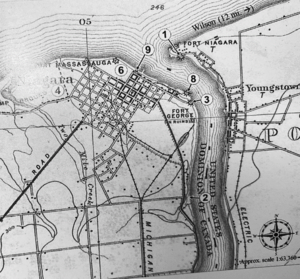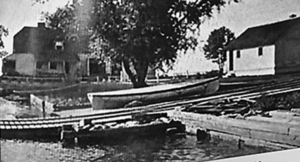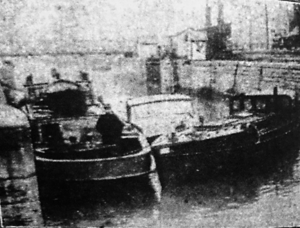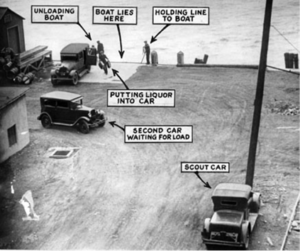Rum Running and Prohibition on Niagara's Waterfront:
Law Enforcement, Smugglers and Border Relations
Leah J. Collard
Buffalo - 2025
From 1920-1933 the United States of America passed the Eighteenth Amendment which banned the sale and transportation of alcohol. This period, known as Prohibition, was one of the biggest social experiments in United States history as it not only affected its own people but its bordering neighbours as well. Many Ontario cities such as Windsor, Hamilton and Niagara were involved in the rum-running business, crossing over the borders to deliver the highly sought-after liquor withheld from Americans. As a result, the Prohibition brought on many new jobs and economic opportunities for both Americans and Canadians. Buying, selling and transporting alcohol was no easy feat but did come with an adequate payout for both sides. The Prohibition led to an uproar from the United States public as many felt entitled to drink alcohol. This led to discovering new ways to transport, buy and sell alcohol under the table, undetected by law enforcement. This was the beginning of rum running and bootlegging, which is defined as the sale and transportation of alcohol from one place to another whilst trying to avoid law enforcement. Therefore, rum runners tried to avoid the law by using creative and calculated plans to sneak across the river undetected. This paper examines how the Niagara River and its bordering lands were prime areas for rum running due to its geographical location and shared border with the United States. Furthermore, this paper will explore the crucial role of law enforcement in preventing alcohol from being transported, as well as their efforts to identify rum runners' patterns and intervene.
The Niagara River divides New York State (America) and the Province of Ontario (Canada) and serves as a natural border between the two countries. In the modern day, people use the Niagara River for power generation and drinking water, but it was a key factor within rum running and smuggling during the 1920's Prohibition period. The river's unique geographical location dividing the lands by only a short distance, at some points a mere 350 meters, created an ideal route for smuggling during the Prohibition. A news article dated November 25th, 1923, highlights that most of the alcohol being run across the Niagara River came from the vicinity of Port Colbourne to the ports in Buffalo as the distance between was short and easy to maneuver.1
Though the Niagara River is in a prime location, bordering Canadian and American shorelines, the water in between can be treacherous and deadly. The river has many different swirling currents and hidden hazards such as rocks and reefs that are able to damage and sink boats without notice.2 With the waters being unpredictable and the best time for smuggling being the depths of the night, rum running was a dangerous and risky business to be a part of. Furthermore, despite the river's ideal location, the hazards within made it a daunting obstacle for those looking to smuggle alcohol.
Many rum runners understood the risks of the business and continued to transport alcohol due to the hopes of a large payout once the job was complete.3 Some bootleggers even gave up their regular jobs to pursue rum running. Despite the geographical advantages of the Niagara area, many rum runners faced personal risks, individuals such as William R. Newman, a former dental technician, gave up his profession to pursue rum-running as a full-time job.4 The risk of rum running was high if caught, there would be legal troubles that would follow and individuals could lose their only income. But the benefits outweighed the risks for many, as the promise of fast money was enough to lure many more into the trade network. Despite the river's dangers, the promise of economic profits kept rum runners in business. However, the success of the rum runners was largely influenced by the shifting legal policies of the United States and Canada.
With Canada and the United States being close in proximity and sometimes sharing only land borders, they are forced to work together when faced with challenges such as bootlegging and rum running. Both countries generally had similar laws and policies, with only minor differences. In 1920 this all changed as both countries now had moral and legal differences due to the passing of the Eighteenth Amendment.5 The restriction of alcohol in America created a relationship for underground businesses to emerge as Americans wanted what the Canadians had, alcohol. The demand from Americans for alcohol fostered a blooming supply and demand chain which enabled Canadians to create business out of smuggling alcohol across the border. Canadian export statistics for the year ending March 31, 1926, show an export of liquor to the United States valued at twelve and a half million dollars which increased by 50% just two years later.6While U.S. officials claimed success in suppressing smuggling from the water, liquor remained readily available, indicating that Canadian smuggling operations were still thriving and playing a critical role in sustaining the trade7. Many rum runners used the profits from bootlegging to supplement their household incomes.8
As smuggling routes expanded, rum runners took advantage of the pre-existing transportation routes such as ports, bridges, and railways to efficiently move alcohol across the border while evading authorities. Figure 1 showcases the upper area of the Niagara River, between Niagara-on-the-Lake, ON and Youngstown, NY.9 All of the ports numbered were prime areas and locations where rum runners and bootleggers had attempted to cross the border undetected by the Coast Guard and Border Security. The ports were very important to the rum-running business as they were used to load boats and ship alcohol across the river. Label 1 within Figure 1 showcases the US Coast Guard station which would be an area to avoid when rum-running as their boats and watchmen were on the lookout. Figure 1.1 is a photograph of the Coast Guard station in Fort Niagara and Youngstown. This station would come to see many seizures and arrests of bootleggers in the following years of the Prohibition.10 Having the Coast Guard stationed at the mouth of the river could have posed some concerns with smuggling into the Niagara River such as random searches or flagging suspicious activity. The location also

Figure 1: Map of the Niagara River and some of the ports used for rum running during the Prohibition.
created new challenges for the Canadian-US border as they now had to have agents on the lookout for smugglers and bootleggers.11

Figure 1.1: Fort Niagara and Youngstown Coast Guard station, 1909.
Law enforcement and border patrol were key elements during the Prohibition and played a crucial role in the attempt to hinder bootlegging and smuggling across the border. Due to the various modes of rum running and bootlegging, law enforcement and border patrol had to be vigilant on both land and water. On the Peace Bridge, the US government added additional

Figure 2: Patrol boats located on the Welland Canal, 1927
inspection officers for incoming travellers as smuggling became more prominent.12 This also caused more frustration for travellers who were coming into the US for business or work and were subjected to long wait lines at the border due to increased inspections. A local newspaper article from Niagara Falls, NY in 1927, states that though the border patrol on the bridge discovered and seized alcohol from cars passing over from time to time, the rum-running boats carried the most cargo.13 This emphasizes the role of water-based smuggling as the dominant method of transportation during Prohibition. This created the need for more advanced coast guard patrol and equipment to be able to catch and stop rum runners on the water. Figure 2 photographs patrol boats that were located on the Welland Canal.14 These boats were used by law enforcement and border patrol seeking to find bootleggers on the river.
The Coast Guard faced the challenge of daylight, as bootleggers and rum runners preferred to operate at night when visibility was limited. The nights on the water were dark and ominous, and if the patrol agents had any chance of catching bootleggers on the water, they were unable to use bright lights on their watch to keep their cover.
Law enforcement, including the U.S. Coast Guard and border patrol, faced significant challenges during Prohibition. Smugglers often operated at night, making surveillance and intervention difficult. Despite their intervention attempts, many rum runners succeeded in evading capture. One night in 1923, Coast Guard agents became alerted to the possible sighting of a boat suspected of rum-running. Unable to see into the darkness, the guards listened to the soft putting of the engine to try and see where it could be coming from. They were able to see the boat in the distance and started to chase it inland, eventually catching up too late as the boat was abandoned with the alcohol still onboard. This was seen as both a success and a failure as the authorities were unable to catch the rum runners however they managed to stop the alcohol from reaching land while obtaining an extra boat for their fleet..15 The boats of the Coast Guard were not made for high-speed chases on the river but rather built to withstand the rough conditions of the Niagara River. Commander Willam E. Reynolds in 1923 requested that the government give the Coast Guard more boats, specifically speed boats in order to catch up to rum runners and bootleggers as the boats the Coast Guard had were unable to do so.16 The United States as an effort to lessen the amount of rum runners, paid dry agents upwards of $250 per week to patrol and guard the borders from rum runners.17 Sometimes the dry agents had backgrounds in rum running and sought after the less dangerous wages as dry agents.18 Border patrol and Coast Guards worked long and strenuous hours during the Prohibition to protect their border from bootlegging, often facing dangerous conditions and fast-changing smuggling tactics used by rum runners determined to breach the border.
Rum running was a business endeavour in which runners had to understand the dangerous risks of smuggling across the river and had to have knowledge of disembarking and docking boats. This was critical due to the dangerous currents, hidden risks within the depths of the Niagara River and how fast and precise they had to be when reaching their destination. Residents of Niagara recalled that most rum runners used rowboats to smuggle liquor across the Niagara River.19 Fishermen became the perfect people to start their own rum-running business or be employed by a rum-running business as they had extensive knowledge of the water and how to maneuver boats throughout the river.20 They also had an advantage as there would be less suspicion from the Coast Guard if the boats were loaded with fishing gear and had men aboard who knew what they were doing. Fishermen used their fishing tools to disguise and hide the liquor they were transporting while using bagged nets that were attached to the bottom of their boats. This allowed them to cut the bags loose and appear to just be out on the water fishing if stopped by Government officials.21 The bags would also be equipped with a pole and salt block, which when melted would allow the liquor to rise to the surface and display the rod.22 This would allow the collectors of the liquor to retrieve the loose bags and bring them across undetected. Having the bags under the boat was more efficient and safer as they were hidden away from sight and could be easily 'disposed of' and hidden within a moment's notice. Other rum runners used "mosquito boats" which were decoy vessels, which would depart and race to the opposing shore as if carrying a cargo of liquor.23 The Coast Guard would chase them down only to find the mosquito boat to be empty of contraband.24
As authorities increased surveillance and patrols on water-based smuggling routes, rum runners expanded their operation routes on land. Canadians expanded their transportation and started to use the railway system to aid them in transporting alcohol.25 The railway enabled rum runners to get alcohol from farther away and transport it to ports where vessels could transport it over the border. Some rum runners who also smuggled on land used cars and other vehicles to transport alcohol over the border. The Peace Bridge served as a critical component to rum running and bootlegging across the border. The Peace Bridge connects Buffalo to Fort Erie and spans the Niagara River, making travel over the river very simple.26 Completed in 1927, the Peace Bridge became the major artery of alcohol smuggling in the Niagara region as it connected Fort Erie to the major roadways in Buffalo.27 This direct access point provided smugglers with easy access over the border and avoided transferring the alcohol from boat to car.
Cars were also crucial components to the smuggling efforts as some rum runners even removed seats in their cars to fit more alcohol.28 One account from a local newspaper in Niagara Falls, NY states that two men were caught with almost 300 quarts of whiskey in their vehicle after arriving in Niagara Falls, NY off of a ferry boarded in Fort Erie.29 There were also rum runners who tried to deceive law enforcement by disguising the alcohol as other items. In one instance there was an attempt to smuggle 500 cases of beer hidden among turnips.30 Cars were also used in the rum-running business for retrieving alcohol from the bootlegging boats once docked. The ability to move quickly and efficiently when transferring alcohol from boat to car was extremely important as law enforcement was on the lookout.

Figure 3: Men in position to transfer bootlegged alcohol from boat to car on a riverbank.
Figure 3 shows an ideal system for transferring alcohol from boat to car. Two cars are waiting to be loaded with alcohol and an extra car available for lookout to warn the other crew about approaching law enforcement.31 This system was used to ensure that the transfer and departure from the dock were smooth and unnoticed. To further reduce the risk of getting caught they removed the stereotype of smugglers from their bootlegging ventures. They hired teenage boys around fifteen or sixteen years old, to row the alcohol across the border.32 This was effective as law enforcement did not expect teenagers to be smuggling alcohol into the United States.
Rum runners were not the only people making profits off of the Prohibition as many farmers on the lands bordering the United States or routes taken by rum runners, rented out their barns for safe havens for liquor shipments.33 This allowed people who were not actively participating within the bootlegging business or rum-running themselves could still make profits off of simply storing alcohol, which was completely legal in Canada. This continued until the end of the Prohibition in 1933, with the introduction of the Twenty-First Amendment which abruptly overturned the Eighteenth Amendment.34
The Prohibition era uncovered the rum-running business, particularly along the Niagara River. Despite the dangerous conditions of the river, rum runners took advantage of the geographical features that made smuggling possible. They actively attempted to avoid the Coast Guard and found creative ways to ensure alcohol would cross the border undetected. Fishing boats, land-based routes, hidden compartments and working at night all created challenges for the Coast Guard in detecting and preventing alcohol from entering the United States. The economic gains with rum running along with the high demand for alcohol coming from the U.S. kept bootleggers in business, despite the risks of natural forces and legal implications. Regardless of seizures and arrests made during the Prohibition, smuggling operations continued which highlights the challenges faced by government officials and law enforcement. The rum runners and bootleggers of the 1920s and 30s stand as a reminder of the persistence, creativity and risks associated with avoiding the law. The Prohibition highlights the interrelationship between countries and the reliance on natural resources for travel and the connectedness of laws and policies not shared between them, particularly between Canada and the United States. The Prohibition not only shaped economic and social changes throughout Canada and the United States but also impacted border security and organized crime in both countries for years to come.
-
Unknown Author, "Niagara Waterfront, Stage for Many Marine Dramas, Now Serves Ends of New Set of Players -- The Rum-Gang," Buffalo Courier, (1923), 52. ↩
-
Unknown Author, "Niagara Waterfront, Stage for Many Marine Dramas," 52. ↩
-
Author Unknown, "Niagara Waterfront, Stage for Many Marine Dramas," 52. ↩
-
Author Unknown, "Once Rum-Runner, Now with Bielaski," The New York Times 76, no. 25184 (1927), 10. ↩
-
John Willis, "Tango along the Canadian -- American Border in the 1920s," American Review of Canadian Studies 48, no. 2 (2018), 165. ↩
-
Marjorie Owen, "The Courts and the Rum-Running Business," Canadian Bar Review 8, no.6 (1930), 413. ↩
-
Owen, "The Courts and the Rum-Running," 413. ↩
-
Timothy Olewniczak, "Giggle Water on the Mighty Niagara: Rum-Runners, Homebrews, Redistillers, and the Changing Social Fabric of Drinking Culture during Alcohol Prohibition in Buffalo, N.Y., 1920-1933," Pennsylvania History: A Journal of Mid-Atlantic Studies 78, no. 1 (2011), 40. ↩
-
Figure 1: [Map of the Niagara River and some of the ports used for rum-running during the prohibition], map, Terry Boulton, "Smuggling on the Lower Niagara River, 1920 -- 1933," (Niagara-on-the-Lake, ON: Niagara Historical Society, 2021), 46. ↩
-
Figure 1.1: [For Niagara and Youngstown Coast Guard Station, 1909], photograph, Terry Boulton, "Smuggling on the Lower Niagara River, 1920 -- 1933," (Niagara-on-the-Lake, ON: Niagara Historical Society, 2021), 3. ↩
-
Olewnickzak, "Giggle Water on the Mighty Niagara," 165. ↩
-
Olewnickzak, "Giggle Water on the Mighty Niagara," 42. ↩
-
Unknown Author, "Fail to See Liquor Craft Have Customs Papers, Probers Hear," Niagara Falls Gazette 35, no. 54 (1927), 1. ↩
-
Figure 2: [Patrol boats located on the Welland Canal, 1927], photograph, Terry Boulton, "Smuggling on the Lower Niagara River, 1920 -- 1933," (Niagara-on-the-Lake, ON: Niagara Historical Society, 2021). 36. ↩
-
Unknown Author, "Niagara Waterfront, Stage for Many Marine Dramas," 52. ↩
-
William H. Thiesen, The Long Blue Line: Catching the rumrunners -- Coast Guard adopts new technology during Prohibition," The United States Coast Guard (2021). ↩
-
Author Unknown, "Once Rum-Runner, Now with Bielaski," 10. ↩
-
Author Unknown, "Once Rum-Runner, Now with Bielaski," 10. ↩
-
Olewnickzak, "Giggle Water on the Mighty Niagara," 40. ↩
-
Boulton, "Smuggling on the Lower Niagara," 5. ↩
-
Boulton, "Smuggling on the Lower Niagara," 6. ↩
-
Boulton, "Smuggling on the Lower Niagara," 6. ↩
-
Andrew Norris, "Rum Row: The Sinking of the Rum Runner I'm Alone," Tulane Journal of International and Comparative Law 24, no.1 (2015), 4. ↩
-
Norris, "Rum Row," 4. ↩
-
Olewnickzak, "Giggle Water on the Mighty Niagara," 40. ↩
-
Olewnickzak, "Giggle Water on the Mighty Niagara," 40. ↩
-
Olewnickzak, "Giggle Water on the Mighty Niagara," 40. ↩
-
Olewnickzak, "Giggle Water on the Mighty Niagara," 40. ↩
-
Author Unknown, "Suspected Rum Running Leader: Arrested in Buffalo with Auto Load of Booze," Niagara Falls Gazette (1926), 14. ↩
-
Author Unknown, "Suspected Rum Running Leader," 40. ↩
-
Figure 3: [Men in position to transfer bootlegged alcohol from boat on a riverbank], photograph, Detroit Public Library Digital Collections (n.d). ↩
-
Olewnickzak, "Giggle Water on the Mighty Niagara," 40. ↩
-
Olewnickzak, "Giggle Water on the Mighty Niagara," 42. ↩
-
Olewnickzak, "Giggle Water on the Mighty Niagara," 57. ↩

